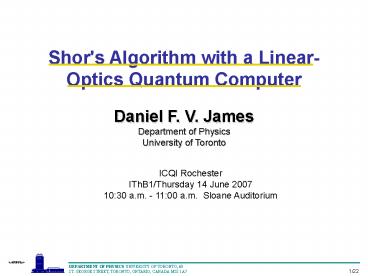Deterministic Quantum Teleportation with Atoms - PowerPoint PPT Presentation
1 / 22
Title:
Deterministic Quantum Teleportation with Atoms
Description:
Mr. Max Kaznadiy (B.Sc. student) Miss. Arghavan Safavi (B.Sc. student) Mr. Ardavan Darabi (B.Sc. ... R. B.Griffiths and C.-S. Niu Phys. Rev. Lett. 76 3228 (1996) ... – PowerPoint PPT presentation
Number of Views:56
Avg rating:3.0/5.0
Title: Deterministic Quantum Teleportation with Atoms
1
Shor's Algorithm with a Linear-Optics Quantum
Computer
Daniel F. V. James Department of
Physics University of Toronto
ICQI Rochester IThB1/Thursday 14 June 2007 1030
a.m. - 1100 a.m. Sloane Auditorium
2
My Shiny Brand New Group at Toronto Dr. René
Stock (postdoc) Mr. Charles Meunier (Ph.D.
student) Miss. Asma Al-Qasimi (M.Sc.
student) Miss. Lucy Zhang (M.Sc. student) Miss.
Hoda Hossein-Nejad (M.Sc. student) Mr. Max
Kaznadiy (B.Sc. student) Miss. Arghavan Safavi
(B.Sc. student) Mr. Ardavan Darabi (B.Sc. student)
Collaborators Prof. Rainer Blatt
(Innsbruck) Prof. Andrew White (Queensland) Prof.
Paul Kwiat (Illinois) Prof. Emil Wolf
(Rochester) ...
3
Whither Quantum Computing? Roadmap Traffic-Light
Diagram (Apr 2004)
1. Scalable qubits
4. Quantum Gates
5. Measurement
2. Initialization
3. Coherence
NMR Algorithmic cooling
Clock states, DFS
NMR
No know approach
Trapped Ions
Theoretical possibility
Neutral Atoms
Photons
Experimental reality
Solid State
SET detectors (?gt 80)
Superconductors
QLD, APL gates
Cavity QED
Entanglement at UCSB
4
Neat experiments like teleportation,
demonstrations of error correction, Bells
inequalities...
Other applications quantum simulations,
repeaters for QKD, metrology, ...
Scalability more qubits and logic gates,
larger scale entanglement, connections between
remote nodes, speed.
Find a signal, then maximize it do Shors
algorithm for simplified, small scale cases, then
progressively improve it.
5
Factoring Numbers
Chose a number, C, which is coprime with N i.e.
GCD(C,N) 1 (easy to check with Euclids
algorithm).
The function fN,C(x) Cx mod N , is
periodic, (period r).
Period Finding ? Factoring
P. Shor, Proc. 35th Ann. Symp. Found. Comp. Sci.
124-134 (1994) also Preskill et al., Phys Rev A
54, 1034 (1996).
6
Classical factoring evaluate fN,C(x) for a
large number of values of x until you can find r.
2L/2 operations replaced by 1 operation
7
(No Transcript)
8
Thus the state after the QFT is
Measurement of the function register yields,
with high probability a number which is a
multiple of N/p extracting p, you can find the
factors.
9
readout
argument
function
10
Unless you get real lucky, N is not a multiple
of r
- you can fix this using bigger registers, so the
periodic signal swamps the rest.
How actually do you implement the unitary
operations for modular exponentiation and quantum
Fourier transform?
- both can be done efficiently (i.e. in a
polynomial number of operations) - break down complicated operations into simpler
operations (e.g. multiplexed adders and repeated
squaring), which can be performed by CNOTs and
related multi-qubit quantum gates. - QFT can be simplified by dropping some
operations, and by doing it semi-classically by
measurement and feed-forward
R. B.Griffiths and C.-S. Niu Phys. Rev. Lett. 76
3228 (1996).
11
N15, C4
12
N15, C4
N15, C2
- x fN,C(x)
- 000 0001
- 001 0010
- 010 0100
- 011 1000
- 100 0001
i.e. period 2
i.e. period 4
this is too profligate with qubits....
13
N15, C4
N15, C2
- x LogCfN,C(x)
- 00 00
- 01 01
- 10 00
- 11 01
- x LogCfN,C(x)
- 000 00
- 001 01
- 010 10
- 011 11
- 100 00
i.e. period 2
i.e. period 4
14
?
QFT
?
15
?
?
?
16
?
Top rail cancellation occurs for all r 2n.
Two qubits, one quantum gate
17
?
QFT
?
?
18
?
?
?
?
?
19
?
?
?
4 qubits, 3 quantum gates (one of which can be
replaced by measurement).
Experimental realization using Linear Optics
for period 2 and 4 (i.e. factoring of 15) See
IFB3/Friday, 1115 a.m.
20
N21, C4
After modular exponentiation, a three qubit
argument register plus two qubit function
register will be in the state ??gt (?000gt?011gt?
???gt)? ?00gt (?00?gt????gt????gt)?
?0?gt ?(?0?0gt????gt)? ??0gt
21
flip qubit 2 ??gt ??gt? ?00gt??gt? ?0?gt?????gt?
??0gt
Can we make this using established techniques
to create W states and GHZ states?
Period is not a power of 2, hence full QFT will
have to be implemented.
Size of the argument register will not be a
factor of the period.
22
Simplified versions of Shors Algorithm are
accessible with todays quantum technology
technology.
Improving these results, step-by-step, is as
good a route to practical quantum computers as
any.
Experiment by Andrew Whites group at
University of Queen Sloane Auditorium, tomorrow,
1115am.































